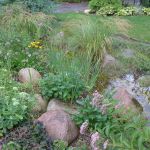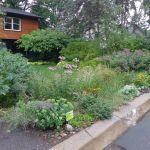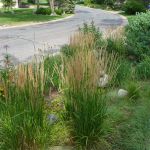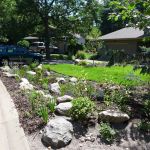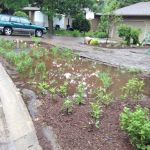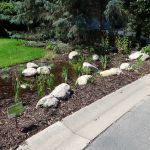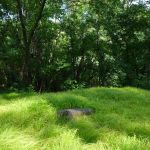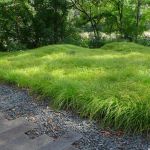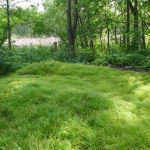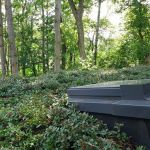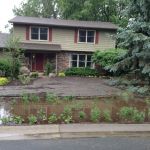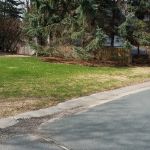Neighborhood Spotlight: Karen Suzukamo
Starting as a buckthorn removal effort as far back as 2012, the Suzukamo family has gradually transformed their yard into a neighborhood oasis for pollinators and stormwater. When Karen was finishing off the restored shade garden in the backyard, she set her attention on the puzzle of the front yard. Here, not only did she find the front yard rather drab, but the curve and slope of the street she’s on created a challenge. As stormwater flows down the street, she noticed that the curve combined with the slope would cause the runoff to spill over into her yard. The situation was especially noticeable in large rain events with more velocity.
Karen approached VLAWMO’s cost-share program with her puzzle and after reviewing other raingarden projects, decided that a raingarden would both solve the wet yard overflow issue while also providing space for her garden passions to flourish.
Garden Chat with Karen
What motivated you to go in this direction for your yard?
I wanted something that I could work on over time and that felt right for this spot. My hope was that as plants thrived or died and my knowledge, time and body changed, the garden and I would evolve together. I began in the backyard with a very satisfying few years of removing a buckthorn forest to better reveal oak, birch, aspen, cherry and maple trees. As I cleared a spot of buckthorn I added snakeroot, Solomon seal and other shade-loving plants.
Eventually the backyard was lovely and I realized the front was pretty ugly--- basically a lawn with a few foundation plants. For the front, I wanted to handle any storm water overflow from the street and have fun with sun-loving plants! I wanted to bring joy to myself, neighbors, and wildlife with flowering plants.
Finally, the last major project was to replace the shade-challenged small lawn in the backyard with native Pennsylvania and oak sedge and to add a sedum roof garden above our kitchen.
How would you describe your creative design process – was it a big vision or pieced together as you went along? What resources helped?
It is an evolutionary process. For the big projects I looked at part of the yard and thought about an overall design. After that it is a process of constant change. I love seeing where plants ‘volunteer’ around the yard. Looking at gardens is a passion of mine. I go on garden tours, look at photos on Instagram and am always happy to walk in a new neighborhood to check out front gardens and chat with gardeners. For the major projects of the raingarden, the backyard sedge and the roof garden I had well-developed ideas of what I wanted and then collaborated with landscaping companies on the detailed design and the installation.
How did the raingarden blend with your existing plantings and yard features?
We left the mature foundation yew, burning bushes and spruce tree. The raingarden, which goes along the entire front edge of the yard, replaced about one-quarter of the lawn. We expanded the plant beds on the other three sides of the yard so that the lawn is now about a quarter of its previous size.
What do you enjoy most about the raingarden?
I love how it changes over the seasons as different plants grow and bloom. There is always something beautiful to see. I also enjoy watching the butterflies and bees stopping by for a meal.
In your experience, how is a sedge groundcover different from a conventional lawn?
It is fantastic! The first year it looked like intermittent hair-plugs but it quickly filled in. The previous lawn always looked scraggly and weedy because of the shade. The sedge looks lush and in the breeze it reminds me of ripples on a lake. It is really beautiful. And--—it is practically no work! It is cut once a year in the late fall. I never water it.
How have the raingarden and groundcover changed your interaction with your yard?
The gardens are far more dynamic than they used to be. They change day to day and season-to-season. As a result, we find it joyful just to sit inside or outside and peacefully observe. And of course as I learn new things or see other gardens I am inspired to think about what is thriving and what is not in my garden. It gives me ideas for what I might contribute to next.
Any advice for other folks who may be interested in a raingarden or groundcover?
Some people love maintaining a lawn but if that isn’t you, sedge groundcovers or a raingarden may be for you!

